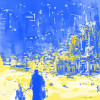ToPics
Life AFTER THE GULAG
A minority began to return from the camps and resettlement after the war, but the great wave of amnesties and liberations began after Stalin’s death and continued until the early 1960s.
Prisoners and resettlers returned after a long journey to native lands they did not recognise, with a changed political regime and sometimes changed borders (Baltic countries, Poland and western Ukraine), to families often decimated by war and purges, and subject, like the entire population, to systematic checks of their biographical background.
Hiding the traces of their dangerous past and keeping silent about it, in order to rebuild a life in a society of many unstated constraints, was a strategy shared by the survivors and their families.
But the silence they were locked into by this strategy affects their memories of return and reintegration with a painful burden of solitude and isolation, increased by the loss of their fellow detainees.
Despite all their efforts, for most of them the stigma of their disreputable past made finding legal housing, a job, higher education or membership of a mass organisation an uphill slog of frustration and danger.
Only in the late 1980s did the political pressure ease off and gradually their thoughts and memories re-emerged within the family and then in public.















